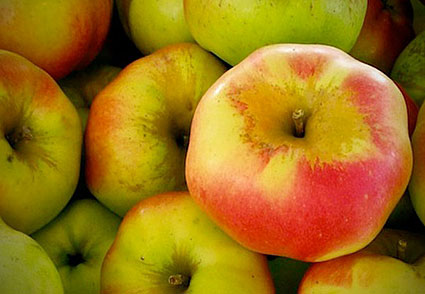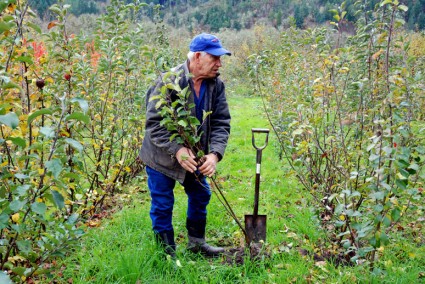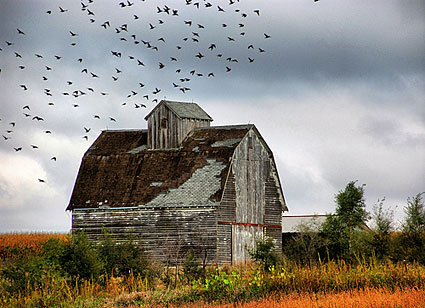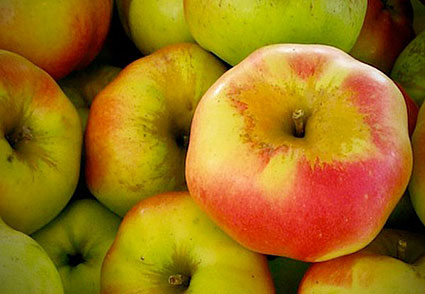 The Calville Blanc d’Hiver, an heirloom variety dating from 15th-century France, will not be showing up in your supermarket, nor will the others in the slideshow below. Photo: Michaela/The Gardener’s EdenYou’ve heard the hackneyed phrase “as American as apple pie.” But America is not taking care of the apples — or the orchard-keepers — that have nourished us for centuries. In 1900, 20 million apple trees were growing in the U.S.; now, not even a fourth remain in our orchards and gardens. Today, much of the apple juice consumed in the U.S. is produced overseas. Of the apples still grown in America, just one variety — Red Delicious — comprises 41 percent of the country’s entire crop, and 11 varieties account for 90 percent of all apples sold in stores.
The Calville Blanc d’Hiver, an heirloom variety dating from 15th-century France, will not be showing up in your supermarket, nor will the others in the slideshow below. Photo: Michaela/The Gardener’s EdenYou’ve heard the hackneyed phrase “as American as apple pie.” But America is not taking care of the apples — or the orchard-keepers — that have nourished us for centuries. In 1900, 20 million apple trees were growing in the U.S.; now, not even a fourth remain in our orchards and gardens. Today, much of the apple juice consumed in the U.S. is produced overseas. Of the apples still grown in America, just one variety — Red Delicious — comprises 41 percent of the country’s entire crop, and 11 varieties account for 90 percent of all apples sold in stores.
When Joe Twine of Richmond, Ky., was growing up, “It was a must to have an orchard. [My father] had orchards…he had apples come in at all times of the year,” he recalls. “You don’t see ’em anymore.”
Of the 15,000 to 16,000 apple varieties that have been named, grown, and eaten in North American, less than 3,500 remain commercially available. Of the surviving varieties, nine out of ten are currently at risk of falling out of cultivation, and falling off our tables.
The drivers of these declines in apple production and diversity are many. There is no single man-made or natural cause. Changing land uses, tastes, and market pressures (far fewer varieties can be found in grocery and big-box stores, which value shipping resilience and item consistency, than in America’s 5,000 farmers markets) have all had their impacts, but even they do not fully explain the long-term decline in the number of orchard-keepers and apple varieties out in the landscape.
Recent studies have suggested that orchard keepers face a new challenge to supplying a variety of apples to their customers. Shifts in weather patterns may be reducing the number of winter chill hours that apple and other trees require in order to bear abundant fruit. If trends continue as predicted, most California orchards are expected to receive less than 500 chill hours per winter by the end of the 21st century. Most apple varieties require 1,000 chill hours per winter to yield harvests large enough to keep orchards economically viable, although some require as little as 800 hours and a few can get by on just 500 chill hours.
In its “high emissions scenario” for climate change, the Union of Concerned Scientists has predicted that orchards in southeastern Pennsylvania will receive 1,000 or more chill hours in just 50 to 60 percent of winters. Because Pennsylvania is the fourth-largest remaining producer of apples in this country, and because much of its $60 million annual crop comes from the southeastern region, these predictions have generated considerable anxiety among orchard keepers. But no one knows how many of the varieties currently being grown there can actually tolerate fewer than 1,000 chill hours — the meteorological projections have not yet been tangibly related to the specific responses of particular varieties. And of course, no one knows for sure how much of the perceived weather shifts are due to global warming or to more localized urban heat-island effects of changing land uses.
 Nick Botner grows more than 3,500 varieties of apples in his southern Oregon orchard — and is always looking for more. Photo: Bob Weimer/Looking for Hope blogFortunately, many talented orchard keepers and cider makers are evaluating now which varieties grow best and produce quality fruit under current conditions. One ambitious octogenarian orchard keeper — Nick Botner — is testing how some 3,000 varieties of apples fare on his seven acres of land in Yoncalla, Ore. Not all of those heirlooms may make it into the next century, but at least Botner can never be accused of putting all his apples in one basket. We may be entering an era when utilizing the diversity of fruits still available to us is the best strategy we may have for facing uncertainty.
Nick Botner grows more than 3,500 varieties of apples in his southern Oregon orchard — and is always looking for more. Photo: Bob Weimer/Looking for Hope blogFortunately, many talented orchard keepers and cider makers are evaluating now which varieties grow best and produce quality fruit under current conditions. One ambitious octogenarian orchard keeper — Nick Botner — is testing how some 3,000 varieties of apples fare on his seven acres of land in Yoncalla, Ore. Not all of those heirlooms may make it into the next century, but at least Botner can never be accused of putting all his apples in one basket. We may be entering an era when utilizing the diversity of fruits still available to us is the best strategy we may have for facing uncertainty.
The Renewing America’s Food Traditions Alliance, an organization I cofounded, is promoting 2010 as the Year of the Heirloom Apple. For further information about how to help preserve America’s fast-disappearing varieties, download RAFT’s newly released Forgotten Fruits Manifesto and Manual (PDF).
Slideshow: For a look at some soon-to-be-forgotten fruit, check out this slideshow of heirloom apple varieties being grown on picturesque Scott Farm in Dummerston, Vt. The photos and text are adapted with permission from a post by horticulturalist and garden designer Michaela of The Gardener’s Eden.



